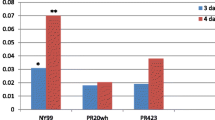Various biological models are used to isolate West Nile virus, but their role as a selection factor that facilitates selection of isolates with certain properties is usually not evaluated. We compared pathogenic properties of three strains of the West Nile virus obtained from one sample of virus-containing material using different models: WNV Volgograd 900m/18 (on the model of suckling mice), WNV Volgograd 900a/18 (on C6/36 cells) and WNV Volgograd 900v/18 (on Vero cells). WNV Volgograd 900m/18 strain demonstrated virulent (LD50 5×103±0.005×104 PFU, p≤0.05) and neuroinvasive properties, induced viremia and pathomorphological changes in the liver, lymph nodes, and brain of nonlinear white mice. WNV Volgograd 900v/18 strain had similar characteristics except for neuroinvasiveness. WNV Volgograd 900a/18 variant demonstrated minimum virulence (LD50 5×104±0.005×104 PFU, p≤0.05), did not cause neurological symptoms, and was not isolated from the blood of infected animals.
Similar content being viewed by others
References
Yanin VL, Bondarenko OM, Sazonova NA. Methods of Research in Cytology and Histology. Khanty-Mansiysk, 2015. Russian.
Benzarti E, Rivas J, Sarlet M, Franssen M, Moula N, Savini G, Lorusso A, Desmecht D, Garigliany MM. Usutu virus infection of embryonated chicken eggs and a chicken embryo-derived primary cell line. Viruses. 2020;12(5):531. doi: https://doi.org/10.3390/v12050531
Chen TH, Tang P, Yang CF, Kao LH, Lo YP, Chuang CK, Shih YT, Chen WJ. Antioxidant defense is one of the mechanisms by which mosquito cells survive dengue 2 viral infection. Virology. 2011;410(2):410-417. doi: https://doi.org/10.1016/j.virol.2010.12.013
Crespo R, Shivaprasad HL, França M, Woolcock PR. Isolation and distribution of West Nile virus in embryonated chicken eggs. Avian Dis. 2009;53(4):608-612. doi: https://doi.org/10.1637/8829-040209-ResNote.1
Donadieu E, Bahuon C, Lowenski S, Zientara S, Coulpier M, Lecollinet S. Differential virulence and pathogenesis of West Nile viruses. Viruses. 2013;5(11):2856-2880. doi: https://doi.org/10.3390/v5112856
Dunbar CA, Rayaprolu V, Wang JC, Brown CJ, Leishman E, Jones-Burrage S, Trinidad JC, Bradshaw HB, Clemmer DE, Mukhopadhyay S, Jarrold MF. Dissecting the components of Sindbis virus from arthropod and vertebrate hosts: implications for infectivity differences. ACS Infect. Dis. 2019;5(6):892-902. doi: https://doi.org/10.1021/acsinfecdis.8b00356
Geoghegan JL, Holmes EC. The phylogenomics of evolving virus virulence. Nat. Rev. Genet. 2018;19(12):756-769. doi: https://doi.org/10.1038/s41576-018-0055-5
Guerrero NAS, Bello FJ. Comparative assessment of the replication efficiency of dengue, yellow fever, and chikungunya arboviruses in some insect and mammalian cell lines. Rev. Soc. Bras. Med. Trop. 2019;52:e20180511. doi: https://doi.org/10.1590/0037-8682-0511-2018
Moser LA, Boylan BT, Moreira FR, Myers LJ, Svenson EL, Fedorova NB, Pickett BE, Bernard KA. Growth and adaptation of Zika virus in mammalian and mosquito cells. PLoS Negl. Trop. Dis. 2018;12(11):e0006880. doi: https://doi.org/10.1371/journal.pntd.0006880
West Nile Virus. Methods and Protocols. Colpitts TM, ed. New York, 2016. doi: https://doi.org/10.1007/978-1-4939-3670-0
Author information
Authors and Affiliations
Corresponding author
Additional information
Translated from Kletochnye Tekhnologii v Biologii i Meditsine, No. 2, pp. 85-89, June, 2021
Rights and permissions
About this article
Cite this article
Molchanova, E.V., Negodenko, A.O., Luchinin, D.N. et al. Influence of Biological Model on the Formation of the Pathogenic Properties of the West Nile Virus Isolate. Bull Exp Biol Med 171, 513–516 (2021). https://doi.org/10.1007/s10517-021-05262-9
Received:
Published:
Issue Date:
DOI: https://doi.org/10.1007/s10517-021-05262-9




